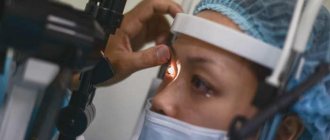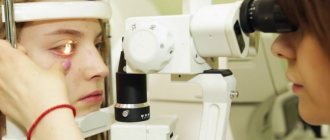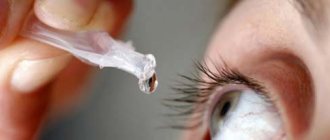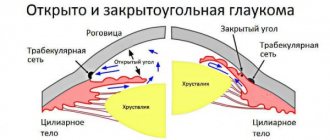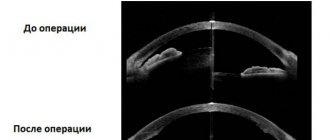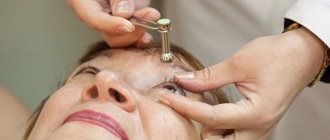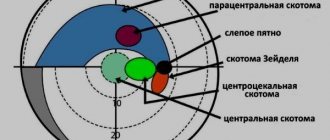Today, glaucoma is one of the leading causes of incurable blindness throughout the world. According to World Health Organization forecasts, the number of patients with glaucoma in the world will increase to 76 million people by 2021. Where does the disease come from, how to recognize it in time and stop it?
Narrated by ophthalmologist at the First City Hospital, Candidate of Medical Sciences Natalya Aleksandrovna Bakunina .
— There are several theories about the occurrence of glaucoma. The most popular and accepted by many specialists is the mechanical-vascular theory, which is based on 2 concepts: mechanical and vascular. The vascular concept considers the central link in the development of glaucoma to be a disturbance of blood circulation in the vessels of the eye and the great vessels of the head and neck. According to the mechanical theory of Academician A.P. Nesterov, important structures of the eye - the optic nerve, retina and others - are damaged by increased intraocular pressure. Many large-scale multicenter studies have proven a direct relationship between the level of intraocular pressure and the progression of the glaucomatous process. What's happening? The outflow of aqueous humor from the eye is primarily disrupted, which leads to an increase in intraocular pressure beyond the individual tolerance level. As a result, ischemia and hypoxia (oxygen starvation) of the optic nerve head, atrophy of the optic nerve, and apoptosis (cell self-destruction) of the optic nerve, retinal ganglion cells and astroglia occur.
Article on the topic
Age-related eye diseases: how to cope with them It has been proven that patients with glaucoma are characterized by impaired hemodynamics (blood movement through the vessels). In a study of patients with suspected glaucoma and with low-tension glaucoma - long before the increase in ophthalmotonus - the authors established progressive pathology of central hemodynamics in 75% of patients, regional and local hemodynamics - in 42-50% of patients. Blood pressure pushes blood, and intraocular pressure, as it were, compresses the vessels from the outside and prevents this pushing. The higher the compression on the outside, the greater the ischemia: the vessels of the eye carry less nutrition and oxygen with the blood to the retina and optic nerve, and the accumulated metabolic products damage the cells. As a rule, intraocular pressure increases at night. And blood pressure decreases at night. Thus, by morning, perfusion pressure (the difference between arterial and intraocular pressure) tends to zero. Next comes the resumption of blood circulation after prolonged damage.
In addition, genetic mechanisms play an important role in the development of glaucoma. It has been proven that mutations in genes can lead to the disease. In most cases - several at once. Relatives of patients with glaucoma have a high chance of getting this disease.
Currently, many studies have appeared on the specific significance of accommodation (a change in the curvature of the lens to focus vision on distant and near objects) in the mechanism of development of primary glaucoma. With age, the activity of the ciliary muscle (controls eye movements) and the amplitude of accommodation decrease, and the outflow of intraocular fluid becomes more difficult. In addition, the lens enlarges. The circulation of intraocular fluid is disrupted, because the root of the iris closes those structures through which the intraocular fluid should flow. Modern technologies make it possible to remove such a lens, which restores the normal anatomy of the anterior chamber angle in the absence of organic changes. This is one of the mechanisms for reducing intraocular pressure in elderly patients with angle-closure glaucoma.
Article on the topic
Catch glaucoma. There are no analogues of the new method of eye examination anywhere in the world. And recent studies have shown that in some cases... one’s own immunity begins to act against the eye. The immune system begins to produce antibodies to photoreceptors or retinal ganglion cells, mistaking them for harmful bacteria and dangerous substances.
However, lowering intraocular pressure, which doctors primarily strive for when treating glaucoma, does not always help. Doctors can achieve a significant decrease in intraocular pressure, and the deterioration of visual functions continues. Therefore, scientists are looking for other mechanisms for the development of glaucoma. The future still lies in genetic research. Knowing which mutations in which genes cause glaucoma in a particular patient (and these combinations may vary from person to person), you can try to find ways to correct and correct damage in DNA. This is what personalized medicine is based on.
Patients with angle-closure glaucoma should not work in an inclined position.
Work in the garden and vegetable garden should be limited. However, you can do weeding while sitting on a low bench, watering with a hose and other light work outdoors. Moderate physical activity is beneficial: light gymnastics and sports exercises, walks in the fresh air, swimming in the pool, skiing.
You should avoid washing and polishing floors, washing clothes, chopping wood, lifting heavy objects, and playing wind instruments. These activities cause blood to rush to the head, which can increase intraocular pressure. For the same reason, overheating of the head is undesirable in glaucoma. You should not stay in a hot bath or near a hot stove for a long time; on sunny days you should not walk with your head uncovered and take long sunbathings. It is advisable to go to the beach before 10 am and after 6 pm.
Diet and drinking regimen for pathology
High-quality nutrition involves a balance between the body's needs and the amount of nutrients and energy supplied from food. In addition, the rhythm of nutrition, the number of meals per day and their distribution throughout the day are important. Principles of nutrition for glaucoma:
- There is not little and not much. Overeating leads to weight gain and strain on all organs. Hunger will lead to a lack of micronutrients, vitamins and fiber;
- Metabolism should occur evenly and constantly throughout the day, therefore you need to eat little and often, the last meal two hours before bedtime;
- Between proteins, carbohydrates and fats there should be an average ratio of 12:55:33, this covers the need for calories and does not create a deficiency of valuable protein and vitamins;
- Food needs to be prepared in a variety of ways. You should vary the side dishes, desserts, and snacks of different flavors. The more varied the food, the richer it is, the higher its value;
- A calm and pleasant atmosphere while eating ensures that food is absorbed and digested;
- Liquids should be no more than one and a half liters per day, including soups. Drink no more than one glass at a time.
Nutrition
Patients with glaucoma are recommended to eat mainly dairy-vegetable foods with nutritional supplements, microelements, vitamins, vegetables and fruits. You should limit the consumption of strong coffee and tea, and avoid smoking, since nicotine has a toxic effect on the central nervous system, optic nerve and retina.
Moderate consumption of wine is possible, but not strong alcoholic drinks. You should limit your fluid intake (tea, water, milk, soups). Their total quantity should not exceed 5 glasses per day. You need to eat 4-5 times a day, preferably at the same hours. Dinner should be 2-3 hours before bedtime. It is necessary to exclude smoked meats, fried meats, salty foods, and hot seasonings from the diet. It is better to cook food in vegetable oil. It is advisable to consume boiled lean meats and fish. Dairy products (kefir, yogurt, yoghurt, cottage cheese), as well as vegetables, berries, and fruits, are healthy.
What not to eat if you have glaucoma
The following products are not recommended for patients with glaucoma:
- Fatty soups and concentrated broths.
- Spices.
- Strong tea.
- Coffee.
- Bakery.
- Canned pickled foods, pickles.
- Liver, lungs, kidneys and other offal.
- Alcoholic drinks.
The given list of food products is unified. Only your doctor can prescribe the optimal diet. He will take into account the patient’s condition, concomitant diseases and propose a personalized diet.
Visual stress, lighting
Visual work at close range (reading, writing, drawing, sewing, etc.) is quite acceptable and even useful, provided there is good lighting.
An increase in intraocular pressure is promoted by staying in the dark (the pupil dilates, the angle of the anterior chamber is closed by the iris). Therefore, patients should not be in a dark room and wear very dark glasses. It is better to sleep in a room without dark curtains. The room should be lit while watching TV.
It is useful to wear glasses with light green lenses, since it has been established that green light slightly reduces intraocular pressure.
In patients with angle-closure glaucoma, staying in the dark can lead to increased intraocular pressure and the development of an acute attack of glaucoma. It is especially important for such patients to read, watch TV in good lighting, and before going to the cinema and theater, instill drops that reduce intraocular pressure.
Lifestyle
Glaucoma itself can seriously disrupt your normal lifestyle, especially if it is diagnosed late enough. If you regularly take the prescribed treatment and follow the doctor's instructions, the course of the disease will slow down. But there are also unforeseen situations, since glaucoma has become much “younger”.
Dream
If you have glaucoma, you should not sleep on a low pillow - it should be high enough and hard enough so that intraocular fluid does not accumulate and there is its outflow. After waking up, you need to get up immediately.
Cloth
It is not recommended to wear sweaters with a narrow neck, tight collars and ties - anything that can impede blood circulation in the neck area.
For angle-closure glaucoma, medications containing atropine are contraindicated, as they can cause an increase in intraocular pressure and even provoke an acute attack of glaucoma (atropine dilates the pupil). This must be remembered when patients with glaucoma consult doctors of other specialties. They need to inform them about their illness. Worry and stress should be avoided. Relatives and friends of the patient play a large role in creating a calm environment.
Sanatorium and resort treatment is of great importance, as it has a positive effect on the general condition of the body.
If you suspect that you have this disease, come to us for glaucoma diagnosis and treatment.
How can you suspect glaucoma?
The most characteristic symptom is a narrowing of the visual field and blurred vision, a veil, a grid before the eyes. But, alas, the appearance of such a sign indicates that the disease has already gone far. A person himself is not able to recognize the initial stages of glaucoma. Glaucoma is like a gentle “killer”, slowly but inevitably destroying vision. However, there is one important sign: glaucoma is characterized by asymmetry. As a rule, the disease begins in one eye. Therefore, you can periodically conduct such a test: close one eye and the other in turn. If you see that the field of vision is narrowing in one eye from the side of the nose, you should immediately run to the doctor. This is how primary open-angle glaucoma begins. If you look with both eyes all the time, it is impossible to see the first changes; one eye will always compensate for the impaired field of vision of the other eye.
Article on the topic
I can't believe my eyes. Why vision deteriorates But for patients with another type of glaucoma - angle-closure - a striking symptom is characteristic. When looking at a bright light or lamp, they see rainbow circles. Plus, periodic pain in the eye and around the eye, and temporary blurred vision are possible. In this case, the structure of the eye is “to blame” for the disease: a large lens (and with age it increases even more), which impedes the outflow of intraocular fluid. In this case, an operation is prescribed to remove the lens and replace it with an artificial one. The anatomy of the eye is restored, intraocular pressure is normalized, and the person is completely cured.
Primary open-angle glaucoma is difficult to treat. Today, doctors can only stop the deterioration of vision at the stage when a person turns to them, and delay blindness with good treatment for an average of 15-20 years. Moreover, the sooner a person comes to an ophthalmologist, the longer it will be possible to maintain vision.
Anyone over 40 years old should measure intraocular pressure every two years: this will make it possible to detect glaucoma in the early stages. If the doctor at the clinic sees a large difference between the pressure in the two eyes (more than 4 mm Hg, even if the values are within the normal range), this is a direct path to examination for glaucoma. It is necessary to carry out daily tonometry: measure eye pressure in the morning and evening for at least 3 days in a row. If the asymmetry in pressure readings is repeated and there is an asymmetry in the visual fields, the person sees that sometimes a veil seems to be creeping over the eyes, and one cannot delay in prescribing treatment.
Initial disturbances cannot be noticed without special equipment. Modern methods for assessing vision include Humphrey computer perimetry, optical coherence tomography, and others. They can show early changes in the optic nerve at a stage when there is no loss of visual fields. However, as a result of such an examination, a specialist may understand that glaucoma should be expected and eye pressure drops should be prescribed more quickly. Intraocular pressure is still the only controllable factor at any stage of the glaucomatous process.
Carrots won't help. Treatment methods that will not save your vision Read more
sunlight
When working for a long time in an overly lit room or being outside, intraocular pressure increases. Therefore, it is recommended to take breaks from working with the PC and wear sunglasses (sold with or without diopters) when going outside.
Patients are contraindicated to work night shifts. Poor lighting forces the pupil to dilate to capture more light to transmit images to the brain. This prevents the outflow of fluid from the chambers of the eye, and there is a high risk of a jump in IOP.
Pregnancy
Every medicine used during pregnancy is considered potentially dangerous to the fetus. However, do not be discouraged and despair. Treatment during pregnancy is carried out and has a beneficial effect on both the condition of the mother and the future baby.
Women planning a pregnancy are advised to consult an ophthalmologist. The doctor will select the most gentle treatment that maximally protects the mother and fetus.
You can only take medications that are prescribed by your ophthalmologist. Strictly follow the dosage and treatment regimen.
Air travel
Air travel rarely affects intraocular pressure (IOP). Because cabin air pressure is carefully regulated as the plane ascends and descends, eye pressure changes little.
However, the movement of air affects the volume of gases in the air. This is relevant for those who have recently had retinal surgery. During surgery, a gas bubble is placed in the eye to help keep the retina in place. The blister is usually present for 6–8 weeks.
Changes in altitude can cause the gas bubble to expand and increase IOP. Therefore, people who have had a gas bladder inserted during retinal surgery are advised to avoid air travel for the next few months.
In contrast, gas bubbles are not used for glaucoma surgery, so people with glaucoma usually have no restrictions on air travel after surgery. However, it is best to consult a doctor before traveling, especially after any type of surgery.
Sauna
IOP in patients reacts in the same way as in healthy people when visiting a steam room or sauna. It decreases and then returns to its original level after about an hour. However, there is no evidence that saunas are beneficial.
Doctors recommend avoiding the sauna and being careful with your favorite pastime. The sauna is definitely beneficial for the body, but if you have glaucoma, it is better to limit its use.
High temperature puts a strong strain on blood vessels and the heart. When you stay in a sauna for a long time, your IOP increases. This is not a strict contraindication, but only a limitation.
conclusions
I think now you have an idea about drinking alcohol for eye diseases, such as cataracts and glaucoma. Alcohol cannot cause a disease such as glaucoma. But when used systematically, in large dosages, it can spoil the course.
To please your friends with such wonderful news, share this article with them. Write comments if there is alcohol on your menu. And I wish you not to be deprived of the joys of life and vision. See you soon, friends. Sincerely, Irina Nazarova.
Some more considerations when drinking alcohol
The first organs it affects are the brain and the entire nervous system, as well as the liver. The effect of alcohol is toxic:
- With regular use, it aggravates the atrophy of the optic nerve, the retina, which is already suffering, under the influence of the disease.
- Concomitant use of alcohol and medications reduces their effectiveness. And you probably know that taking medications for glaucoma is an extremely necessary action. Otherwise, there is a risk of vision loss.
- When consumed in large quantities, a person can lose orientation, fall, for example, with a head injury; the resulting injury can also negatively affect the underlying disease. Unfortunately, falls and injuries among alcohol drinkers are common.
So far, we see that the compatibility of alcohol and glaucoma is very doubtful.
You may be interested in: List of the most popular drugs for the treatment of glaucoma and their principle of action
Drops to reduce the production of intraocular fluid
Controlling the production of intraocular fluid reduces ophthalmotonus. These medications are characterized by the properties of diuretics, that is, they remove excess fluid from the body.
Carbonic anhydrase inhibitors
Medicines:
- Azopt;
- Acetazolomide;
- Trusopt;
- Brinzolamide;
- Dorzolamide.
The drops have virtually no effect on organs and do not cause side effects on the respiratory/nervous/cardiac and vascular systems. Brinzolamide and Dorzolamide are prescribed for open-angle glaucoma and ocular hypertension. Other drugs also help optimize the fluid level in the eye chambers; treatment is determined by an ophthalmologist.
Beta blockers
Medicines:
- Adrenergic and sympathomimetics (Clonidine);
- Antiadrenergic drugs (Timolol, Betaxolol);
- Antienzymes (Dorzolamide, Brinzolamide, Acetazolamide);
- Combined medications (Fotil, Xalacom, Proxofelin).
Medicines are taken under the supervision of an ophthalmologist. The dosage is determined individually.

